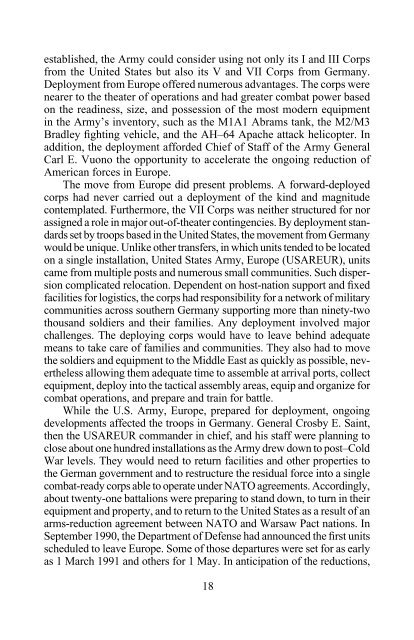You also want an ePaper? Increase the reach of your titles
YUMPU automatically turns print PDFs into web optimized ePapers that Google loves.
established, the Army could consider using not only its I and III Corpsfrom the United States but also its V and VII Corps from Germany.Deployment from Europe offered numerous advantages. The corps werenearer to the theater of operations and had greater combat power basedon the readiness, size, and possession of the most modern equipmentin the Army’s inventory, such as the M1A1 Abrams tank, the M2/M3Bradley fighting vehicle, and the AH–64 Apache attack helicopter. Inaddition, the deployment afforded Chief of Staff of the Army GeneralCarl E. Vuono the opportunity to accelerate the ongoing reduction ofAmerican forces in Europe.The move from Europe did present problems. A forward-deployedcorps had never carried out a deployment of the kind and magnitudecontemplated. Furthermore, the VII Corps was neither structured for norassigned a role in major out-of-theater contingencies. By deployment standardsset by troops based in the United States, the movement from Germanywould be unique. Unlike other transfers, in which units tended to be locatedon a single installation, United States Army, Europe (USAREUR), unitscame from multiple posts and numerous small communities. Such dispersioncomplicated relocation. Dependent on host-nation support and fixedfacilities for logistics, the corps had responsibility for a network of militarycommunities across southern Germany supporting more than ninety-twothousand soldiers and their families. Any deployment involved majorchallenges. The deploying corps would have to leave behind adequatemeans to take care of families and communities. They also had to movethe soldiers and equipment to the Middle East as quickly as possible, neverthelessallowing them adequate time to assemble at arrival ports, collectequipment, deploy into the tactical assembly areas, equip and organize forcombat operations, and prepare and train for battle.While the U.S. Army, Europe, prepared for deployment, ongoingdevelopments affected the troops in Germany. General Crosby E. Saint,then the USAREUR commander in chief, and his staff were planning toclose about one hundred installations as the Army drew down to post–ColdWar levels. They would need to return facilities and other properties tothe German government and to restructure the residual force into a singlecombat-ready corps able to operate under NATO agreements. Accordingly,about twenty-one battalions were preparing to stand down, to turn in theirequipment and property, and to return to the United States as a result of anarms-reduction agreement between NATO and Warsaw Pact nations. InSeptember 1990, the Department of Defense had announced the first unitsscheduled to leave Europe. Some of those departures were set for as earlyas 1 March 1991 and others for 1 May. In anticipation of the reductions,18












